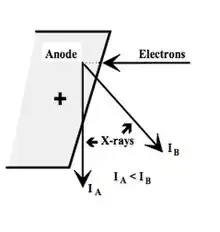
In X-ray tubes, the heel effect or, more precisely, the anode heel effect is a variation of the intensity of X-rays emitted by the anode depending on the direction of emission along the anode-cathode axis. X-rays emitted toward the anode are less intense than those emitted perpendicular to the cathode–anode axis or toward the cathode. The effect stems from the absorption of X-ray photons before they leave the anode in which they are produced. The probability of absorption depends on the distance the photons travel within the anode material, which in turn depends on the angle of emission relative to the anode surface.[1][2]
Factors
Source-to-image distance (SID)
The distance from the anode (the source of X-rays) to the image receptor influences the apparent magnitude of the anode heel effect. At short SID, image receptor captures a wider range of X-ray intensities than the same size image receptor at larger source–image distances (SID).[3][4]
Beam width and receptor size
Wide X-ray beams can be cropped to narrow x-ray beams by use of a beam restricting device (variable-aperture x-ray "collimator", fixed aperture, or cone). A beam that is wide along the cathode–anode axis contains a wider range of X-ray intensities than a narrow beam. In a wide beam, a large image receptor captures a wider range of X-ray intensities than a small receptor (at the same SID). Both of these factors influence the visibility of the anode heel effect. A smaller field size results in a less pronounced heel effect.[5][6]
Anode angle
When the angle of the anode is large, the usable X-ray photons do not have to travel through as much of the anode material to exit the tube. This results in a much less apparent anode heel effect, though the effective focal spot size is increased.[4][7][8]
Solutions
Almost all modern diagnostic X-ray generators exhibit heel effect. Graded intensity across the beam, generally a drawback, can be turned to advantage in some techniques by positioning the object or patient relative to the X-ray tube. For example, when imaging a foot, which is thicker at the ankle end than the toes, the toes should be positioned toward the anode and the ankle toward the cathode.[6] Arbitrary intensity gradients can also be produced by placing a beam compensator (a wedge of homogeneous material) across the X-ray beam before exposure.
There have also been some efforts to eliminate the heel effect through automatic software adjustment of pixel values.[9]
References
- ↑ "Figure 3-12. Anode heel effect. - Fundamentals of X-Ray Physics". Integrated Publishing. Retrieved 9 December 2016.
- ↑ Curry, Thomas S.; Dowdey, James E.; Murry, Robert C. (1990). Christensen's physics of diagnostic radiology (4th ed.). Philadelphia: Lea & Febiger. p. 18. ISBN 9780812113105.
- ↑ Ghom, A. G. (2009). Textbook of Oral Radiology. Elsevier India. p. 52. ISBN 9788131211489.
- 1 2 Huda, Walter (2010). Review of radiologic physics (3rd ed.). Baltimore, MD: Lippincott Williams & Wilkins. p. 26. ISBN 9780781785693.
- ↑ Thayalan, K. (2003). Basic Radiological Physics. New Delhi: Jaypee Brothers Publishers. p. 66. ISBN 9788171798544.
- 1 2 Bontrager, Kenneth L.; Lampignano, John (2013). Textbook of Radiographic Positioning and Related Anatomy. Elsevier Health Sciences. p. 38. ISBN 9780323277556.
- ↑ Mesbahi, Asghar; Zakariaee, Seyed-Salman (May 2013). "Effect of anode angle on photon beam spectra and depth dose characteristics for X-RAD320 orthovoltage unit". Reports of Practical Oncology & Radiotherapy. 18 (3): 148–152. doi:10.1016/j.rpor.2012.12.001. PMC 3863179. PMID 24416546.
- ↑ Andolina, Valerie F.; Lille, Shelly (2010). Mammographic Imaging: A Practical Guide (3rd ed.). Philadelphia, Pa.: Lippincott Williams & Wilkins. p. 238. ISBN 9781605470313.
- ↑ do Nascimento, Marcelo Zanchetta; Frère, Annie France; Germano, Fernao (11 September 2007). "An Automatic Correction Method for the Heel Effect in Digitized Mammography Images". Journal of Digital Imaging. 21 (2): 177–187. doi:10.1007/s10278-007-9072-1. PMC 3043860. PMID 17846833.